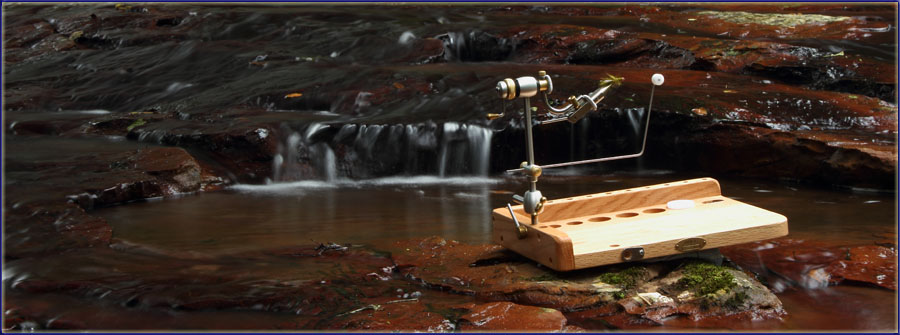
For over 10 years I tied my flies on an entry vice which I bought while on a limited budget at University. And for many years I believed that all vices were made equal; that was until the day I got to tie a fly using the Jvice.
Suddenly I realised just how wrong I’d been. Yes, perhaps the final fly looked similar, but the process of tying it differed greatly. The Jvice was faster, more efficient and far easier to use. I was once again excited to tie flies and was suddenly tying twice as many in half the time.
I immediately decided to review the Jvice and was lucky enough to meet Jay Smit and to spend some time with him at his production facility. Never have I met someone quite so enthusiastic about their product. He oozed passion and that can certainly be seen in the design and quality of the Jvice. Each bend of the vice, every single screw and each moving part has a purpose and was carefully thought through.
His passion can also be seen through his service and sales. “Good service” is his motto and he certainly lives up to it. The Jvice is generally not stocked in shops as Jay prefers to interact with his customers so that he can better understand their requirements. This allows him to ensure that each vice is set up correctly for the individual.
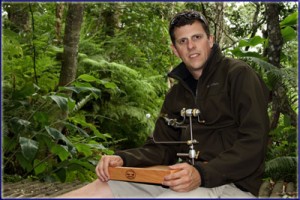
Jay also listens to his customers’ needs and requests. In the past these requests have proved so useful that some of them have become part of the Jvice’s design and its corresponding product range.
Another reason that this vice is so well designed is that it was designed by a fly tyer for fly tyers. In fact Jay was the chairman of the Durban Fly Tyers Club (www.durbanflytyers.co.za) for many years and continues to do demonstrations there whenever possible.
Key to the success and design of the Jvice is its long history. Hearing it should give you some idea as to how the product started and how it grew to what it is today, perhaps the most versatile fly tying vice on the market.
Jay was born on a farm in Howick, South Africa, and spent many of his early years repairing machinery ranging from water pumps to tractors. He later studied electronics and worked for Eskom for 17 years before moving to a manufacturing company in Durban. There Jay found himself modifying and building custom machinery to improve production. This led him on to becoming the Technical Director of a group where he set up a small division that built specialised production machines.
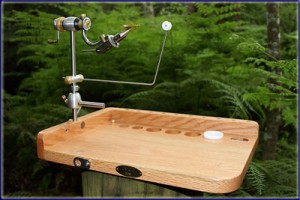
Jay grew up fishing the salt and it was only in his 20s that he discovered fly fishing. It was however short lived and took a back seat until 2001 when he rediscovered it on a trip to the Drakensberg. There, after many hours on the water, he landed his first fish (a 1.5kg rainbow trout) and was hooked for life.
After landing that first fish Jay decided to take up fly tying and bought himself an entry level rotary vice. This vice proved more frustrating than anything and it soon find itself a permanent home in his dustbin.
Convinced that he could do it better Jay immediately began work on his own vice. This required a lot of research and many sketches before he entered his workshop and made his first vice. He tied flies on this vice for several weeks continuously making notes. These notes lead to the second version of the vice and finally the third which worked to his satisfaction.
In 2002 Jay went on a salt water outing with Ufundu. His guide Ben was highly impressed with his vice and asked him to produce more for him to sell. The vice had taken over 40 hours to hand make and Jay was not immediately sold on the idea thinking it would prove too expensive to mass produce.
However after much pestering he eventually gave in, met with a friend who owned a CNC machine, and had 50 vices produced at his own cost. This process required a few tweaks in the vice’s design to make it more machine friendly which in turn added to the growing costs.
By the end of the year 37 of the 50 vices had been sold and the idea of selling them was becoming a reality, as was the hope of making up his initial investment.
Towards the end of 2003 the vice ended up in the hands of Hans Weilenmann, one of the world’s leading fly tyers, who wrote a good review of it. Hans’ few concerns have since been taken into account and the vice improved as a result of this.
Further reviews were written and orders began being placed internationally. This led to the creation of the Jvice website which allowed Jay to include his passion for photography into the process.
Ed Herbst then got his hands onto the vice which created a whole new challenge for Jay. Ed is one of the country’s leading authorities on ultra-light tackle and immediately wanted a set of midge jaws. Thankfully he provided a lot of input and information as to how to make this work and, 12 prototypes later, Jay had a working set of midge jaws. This, in its own way, led to the development of the gooseneck which now comes standard with the vice.
Several other fly tyers also made use of the vice and many of their ideas were incorporated into what is now the Jvice.
With sales growing and the cost of components rising Jay decided to purchase a CNC lathe to allow him to produce the vices himself as well as to improve quality. The new machine also allowed him to run smaller batches and thus to experiment with ideas without the hindrance of minimum batches. This lead to developments like the tube fly attachment, backdrop card holder, articulated bobbin rest, deer hair packer and more.
To this day Jay maintains that no other vice on the market is as versatile as the Jvice, a statement which I most certainly believe.
If it’s history interests you, you can find the full story on the Jvice website at http://www.jvice.com. Knowing now where the Jvice came from let’s move on to the vice itself.
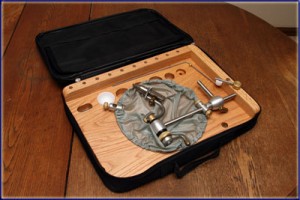
When I received my vice it came packed in the travel position inside its handy carry bag. This capability makes it exceptionally easy to transport and I now take it with me on all holidays, whether it’s a fishing trip or not, allowing me to tie flies in my free time.
The vice was originally designed to fit into a standard laptop bag but Jay soon began producing his own bag which is a better fit. It also has a Velcro style pocket which can hold the optional extras, some of your tools and perhaps even a few fly tying materials for a short trip.
Upon opening the travel bag and setting up the vice I became instantly aware of the versatility of the product. It’s solid oak base allows one to tie flies on their laps or on a table top via the two different positions in which the vice can be locked to the base. Again this is a feature which has been exceptionally useful, especially since it allows me to tie flies on the couch while enjoying a cricket match or whatever else is on TV. The base is also exceptionally well designed and there are various recesses in it for both your tools and tying materials.
Note: The base which comes standard with the vice is set up for right handed fly tyers. If you tie left handed remember to inform Jay so that he can set up your base accordingly.
While using the vice it was easy to see and feel the quality of the materials. The Jvice’s adapters and thumbscrews are all made from brass while the main shaft is made from 316 stainless steel. The housing bushes and fittings are stock aluminium and are anodized black with the option of red or blue.
The Jvice comes with a small waste basket which attaches to the main shaft. This is the perfect device to stop household arguments as it collects all the small clippings of cotton, feather and hair that fall from the vice during tying. I’ve even heard of people using the clippings in this bin to dub the bodies of their flies.
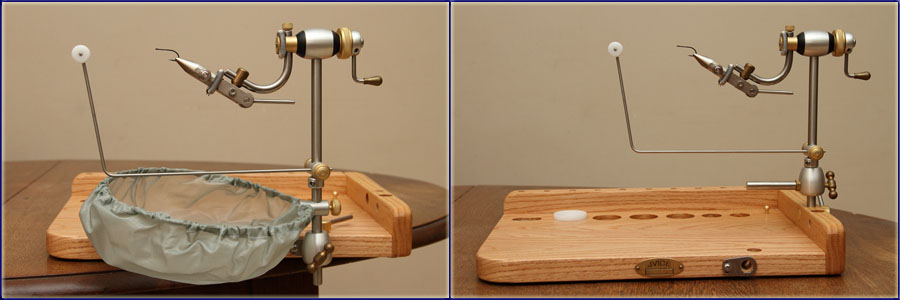
The waste basket should also be laid down under the vice when packing it away to protect the wooden base from minor scratches caused by the vice.
The jaws which come with the vice are capable of holding hooks of sizes 6/0 to 22. These are made from tool steel hardened to Rockwell C55. They are then treated to get the required finish and are finally plated with nickel.
The jaws use a dual mechanism to hold the fly securely. First a knob on the side jaws adjusts the width of the gap the hook sits in. The hook is then secured between the jaws using a cleverly designed three way cam system.
It’s also worth mentioning that the jaw have grooves cut into them allowing them to hold larger hooks securely.
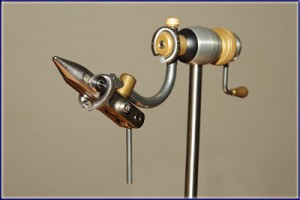
As an optional extra one can order the midge jaws for holding tiny hooks but I’d imagine that these are only necessary if one is tying mainly small nymphs and dry flies. The pro jaws can hold small enough hooks for people like me who tie flies ranging from small dries to larger salt water streamers.
A hackle spring has been wrapped around the jaws to hold your cotton, hackles, copper wire, etc out of the way while tying. There is also a second hackle spring around the body which is perfectly placed for larger salt water flies.
Being a rotary vice it’s important that we discuss the rotary mechanism. The bushes used for the mechanism are turned from Ertalite which is extremely durable and gives the rotary function an extremely smooth action.
The rotary action, for those of you who’ve never used it before, is extremely useful for getting full access to the fly. It also makes tying in hackles far easier and more accurate. Another benefit is that it allows you to turn the fly upside down (to tie in wings underneath) without having to remove the fly from the vice and reattach it.
The rotary action can be locked into place using a thumb screw (or just tightened and loosened as needed). The thread on the thumb screw is incredibly fine which means that the level of friction in the rotary action can be adjusted to suit the fly tyer’s preferences.
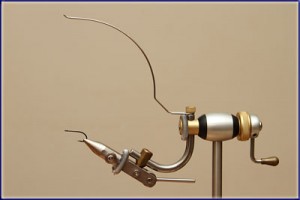
Note: It is important to set your fly such than when rotating it the hook shank stays level and merely rotates. This is normally achievable by placing the hook correctly in the jaws however, if need be, the jaws can be easily adjusted with an Allen key.
While chatting about the rotary action it is also useful to mention the gooseneck. One can comfortably rest their hand in the neck while tying and then, by moving the hand backwards and forwards, can also rotate the vice to some degree.
Over and above the standard features discussed the Jvice also has a lot of extras which can be purchased either with the vice or separately.
Unfortunately I haven’t had the chance to use most of these extras and hence will have to review them separately at a later stage. It is however worth mentioning a few of them here to let you know just how versatile this vice is and just how many options there are.
The gallows tool is extremely useful for tying paraloops and is one of the extras which comes with the Jvice. Unlike other gallow tools this one rotates with the vice making it easier to use since it doesn’t get in the way and allows one to continue using the rotary feature.
The bobbin rest also comes with the vice and is extremely useful; although it does take some getting used to as initially I found it to be in the way. A better option may be the articulating bobbin rest as it folds out of the way while still being able to hold the bobbin (behind the fly rather than next to it). This is however an optional extra.
Other extras include:
- The midge jaws which are ideal for people tying small dries and nymphs.
- The salt water streamer attachment which holds the fly’s tail in place while epoxying the body of the fly.
- The tube fly attachment which is used for tying flies onto tubes rather than hooks.
- The camera and card holder for taking photos of flies or filming your fly tying.
- The deer hair packer which simplifies the process of spinning deer hair.
- The hair stacker which is beautifully designed in copper and a must for any fly tyer.
- The dubbing spinner for easily dubbing loops. It also fits perfectly into the base for convenience.
- The dubbing brush maker which allows one to make their own dubbing ropes.
As well as the above mentioned extras the Jvice range is constantly growing and new items are being added all the time. The vice is also improved from time to time but generally the new pieces are backwards compatible should you want them.
In case you’re wondering, the Jvice does come with a lifetime guarantee – Jay’s life that is. That said the vice is so well made that the chance you’ll ever need to use this is slim. This vice really should last you a lifetime.
In summary, besides just looking incredible, the Jvice is an exceptional piece of equipment solidly built to the highest standards. It will last you a lifetime of fly tying and has a flexibility no other vice offers. As far as top end vices go, you simply can’t beat the Jvice, especially at the price.
– By Warren Prior
